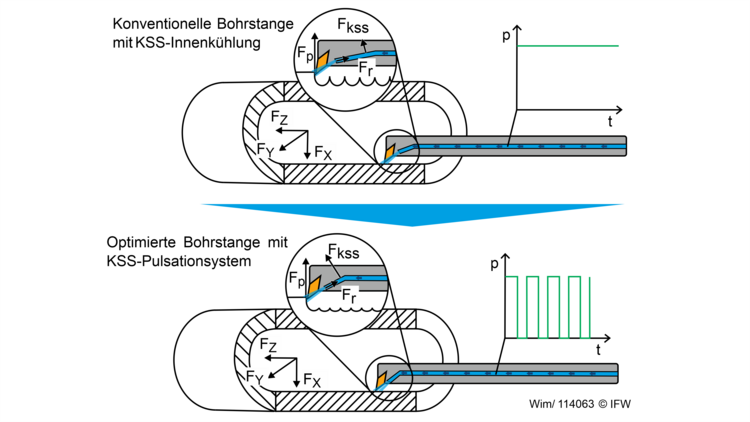Development of an actively damped boring bar by means of a pulsed jet of cooling lubricant
 © IFW
© IFW
| Led by: | Prof. Dr.-Ing. Berend Denkena |
| E-Mail: | Wickmann@ifw.uni-hannover.de |
| Team: | Moritz Wickmann |
| Year: | 2022 |
| Date: | 08-06-22 |
| Funding: | AiF Projekt GmbH |
| Duration: | 08/2021-11/2023 |
The susceptibility to vibration and chatter of long projecting boring bars results in lower productivity. To reduce the susceptibility to vibration, carbide boring bars and auxiliary mass dampers are used. However, due to the required installation space for the damping elements, boring bars with a diameter D < 16 mm cannot be damped. Nowadays, mainly passive damping methods are offered industrially on the market for diameters with D >= 16 mm. A disadvantage of passive damping elements is that they have to be adapted at great expense if the vibration properties of the boring bar are changed due to altered cutting conditions. Higher damping dimensions and the possibility of adaptation to changed boundary conditions are regarded as advantages of active damping elements. However, the complex and cost-intensive energy supply and control of the piezo or magnetic actuators used so far prevent market penetration.
The new approach to implementing an active system for damping thin, long projecting drill rods is based on the use of the existing cooling lubricant (KSS). The pulsation of the MWF applies a force in the boring bar to disturb the vibrations from the process. This damping concept does not require any additional elements in the boring bar and is therefore also suitable for boring bars with small diameters. For this purpose, sensors and valves are installed upstream of the boring bar to allow pulsation of the coolant. One challenge is the targeted application of the pulsation force to create destructive rather than constructive interference with the vibrations.
The initial goal is to create a simulation-based tool to analyze the boring bar vibration and it's pulsation effect. For this purpose, the drill rod will be simulated using the finite element method (FEM) and the KSS will be simulated using fluid simulations (CFD). The simulations are validated by tests.




















